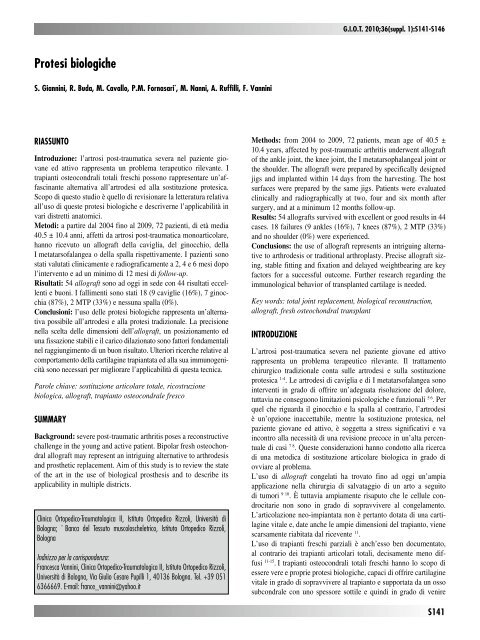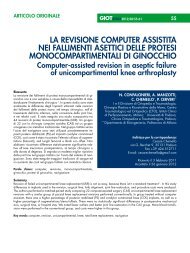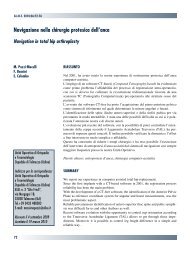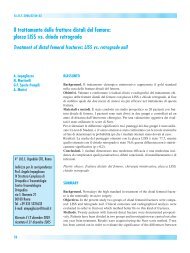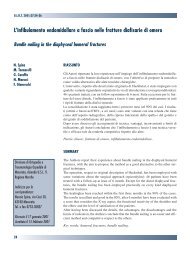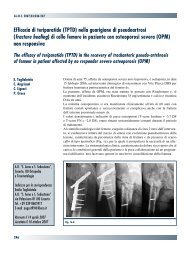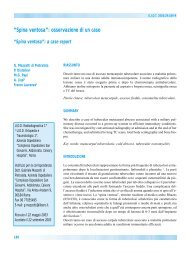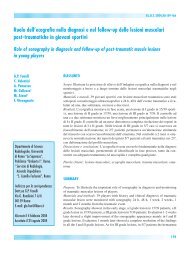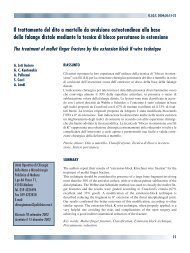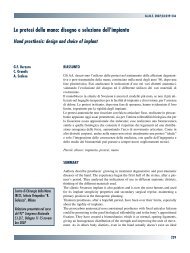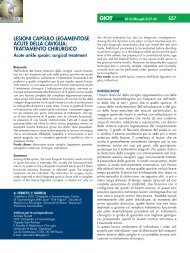30845 Suppl Giot.pdf - Giornale Italiano di Ortopedia e Traumatologia
30845 Suppl Giot.pdf - Giornale Italiano di Ortopedia e Traumatologia
30845 Suppl Giot.pdf - Giornale Italiano di Ortopedia e Traumatologia
You also want an ePaper? Increase the reach of your titles
YUMPU automatically turns print PDFs into web optimized ePapers that Google loves.
Protesi biologiche<br />
S. Giannini, r. Buda, M. Cavallo, P.M. Fornasari * , M. Nanni, a. ruffilli, F. Vannini<br />
rIaSSuNTO<br />
Introduzione: l’artrosi post-traumatica severa nel paziente giovane<br />
ed attivo rappresenta un problema terapeutico rilevante. I<br />
trapianti osteocondrali totali freschi possono rappresentare un’affascinante<br />
alternativa all’artrodesi ed alla sostituzione protesica.<br />
Scopo <strong>di</strong> questo stu<strong>di</strong>o è quello <strong>di</strong> revisionare la letteratura relativa<br />
all’uso <strong>di</strong> queste protesi biologiche e descriverne l’applicabilità in<br />
vari <strong>di</strong>stretti anatomici.<br />
Meto<strong>di</strong>: a partire dal 2004 fino al 2009, 72 pazienti, <strong>di</strong> età me<strong>di</strong>a<br />
40.5 ± 10.4 anni, affetti da artrosi post-traumatica monoarticolare,<br />
hanno ricevuto un allograft della caviglia, del ginocchio, della<br />
I metatarsofalangea o della spalla rispettivamente. I pazienti sono<br />
stati valutati clinicamente e ra<strong>di</strong>ograficamente a 2, 4 e 6 mesi dopo<br />
l’intervento e ad un minimo <strong>di</strong> 12 mesi <strong>di</strong> follow-up.<br />
Risultati: 54 allograft sono ad oggi in sede con 44 risultati eccellenti<br />
e buoni. I fallimenti sono stati 18 (9 caviglie (16%), 7 ginocchia<br />
(87%), 2 MTP (33%) e nessuna spalla (0%).<br />
Conclusioni: l’uso delle protesi biologiche rappresenta un’alternativa<br />
possibile all’artrodesi e alla protesi tra<strong>di</strong>zionale. La precisione<br />
nella scelta delle <strong>di</strong>mensioni dell’allograft, un posizionamento ed<br />
una fissazione stabili e il carico <strong>di</strong>lazionato sono fattori fondamentali<br />
nel raggiungimento <strong>di</strong> un buon risultato. Ulteriori ricerche relative al<br />
comportamento della cartilagine trapiantata ed alla sua immunogenicità<br />
sono necessari per migliorare l’applicabilità <strong>di</strong> questa tecnica.<br />
Parole chiave: sostituzione articolare totale, ricostruzione<br />
biologica, allograft, trapianto osteocondrale fresco<br />
SuMMary<br />
Background: severe post-traumatic arthritis poses a reconstructive<br />
challenge in the young and active patient. Bipolar fresh osteochondral<br />
allograft may represent an intriguing alternative to arthrodesis<br />
and prosthetic replacement. Aim of this study is to review the state<br />
of the art in the use of biological prosthesis and to describe its<br />
applicability in multiple <strong>di</strong>stricts.<br />
Clinica Ortope<strong>di</strong>co-Traumatologica II, Istituto Ortope<strong>di</strong>co Rizzoli, Università <strong>di</strong><br />
Bologna; * Banca del Tessuto muscoloscheletrico, Istituto Ortope<strong>di</strong>co Rizzoli,<br />
Bologna<br />
In<strong>di</strong>rizzo per la corrispondenza:<br />
Francesca Vannini, Clinica Ortope<strong>di</strong>co-Traumatologica II, Istituto Ortope<strong>di</strong>co Rizzoli,<br />
Università <strong>di</strong> Bologna, Via Giulio Cesare Pupilli 1, 40136 Bologna. Tel. +39 051<br />
6366669. E-mail: france_vannini@yahoo.it<br />
G.I.O.T. 2010;36(suppl. 1):S141-S146<br />
Methods: from 2004 to 2009, 72 patients, mean age of 40.5 ±<br />
10.4 years, affected by post-traumatic arthritis underwent allograft<br />
of the ankle joint, the knee joint, the I metatarsophalangeal joint or<br />
the shoulder. The allograft were prepared by specifically designed<br />
jigs and implanted within 14 days from the harvesting. The host<br />
surfaces were prepared by the same jigs. Patients were evaluated<br />
clinically and ra<strong>di</strong>ographically at two, four and six month after<br />
surgery, and at a minimum 12 months follow-up.<br />
Results: 54 allografts survived with excellent or good results in 44<br />
cases. 18 failures (9 ankles (16%), 7 knees (87%), 2 MTP (33%)<br />
and no shoulder (0%) were experienced.<br />
Conclusions: the use of allograft represents an intriguing alternative<br />
to arthrodesis or tra<strong>di</strong>tional arthroplasty. Precise allograft sizing,<br />
stable fitting and fixation and delayed weightbearing are key<br />
factors for a successful outcome. Further research regar<strong>di</strong>ng the<br />
immunological behavior of transplanted cartilage is needed.<br />
Key words: total joint replacement, biological reconstruction,<br />
allograft, fresh osteochondral transplant<br />
INTrODuzIONE<br />
L’artrosi post-traumatica severa nel paziente giovane ed attivo<br />
rappresenta un problema terapeutico rilevante. Il trattamento<br />
chirurgico tra<strong>di</strong>zionale conta sulle artrodesi e sulla sostituzione<br />
protesica 1-4 . Le artrodesi <strong>di</strong> caviglia e <strong>di</strong> I metatarsofalangea sono<br />
interventi in grado <strong>di</strong> offrire un’adeguata risoluzione del dolore,<br />
tuttavia ne conseguono limitazioni psicologiche e funzionali 5 6 . Per<br />
quel che riguarda il ginocchio e la spalla al contrario, l’artrodesi<br />
è un’opzione inaccettabile, mentre la sostituzione protesica, nel<br />
paziente giovane ed attivo, è soggetta a stress significativi e va<br />
incontro alla necessità <strong>di</strong> una revisione precoce in un’alta percentuale<br />
<strong>di</strong> casi 7 8 . Queste considerazioni hanno condotto alla ricerca<br />
<strong>di</strong> una meto<strong>di</strong>ca <strong>di</strong> sostituzione articolare biologica in grado <strong>di</strong><br />
ovviare al problema.<br />
L’uso <strong>di</strong> allograft congelati ha trovato fino ad oggi un’ampia<br />
applicazione nella chirurgia <strong>di</strong> salvataggio <strong>di</strong> un arto a seguito<br />
<strong>di</strong> tumori 9 10 . È tuttavia ampiamente risaputo che le cellule condrocitarie<br />
non sono in grado <strong>di</strong> sopravvivere al congelamento.<br />
L’articolazione neo-impiantata non è pertanto dotata <strong>di</strong> una cartilagine<br />
vitale e, date anche le ampie <strong>di</strong>mensioni del trapianto, viene<br />
scarsamente riabitata dal ricevente 11 .<br />
L’uso <strong>di</strong> trapianti freschi parziali è anch’esso ben documentato,<br />
al contrario dei trapianti articolari totali, decisamente meno <strong>di</strong>ffusi<br />
11-15 . I trapianti osteocondrali totali freschi hanno lo scopo <strong>di</strong><br />
essere vere e proprie protesi biologiche, capaci <strong>di</strong> offrire cartilagine<br />
vitale in grado <strong>di</strong> sopravvivere al trapianto e supportata da un osso<br />
subcondrale con uno spessore sottile e quin<strong>di</strong> in grado <strong>di</strong> venire<br />
S141


